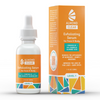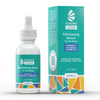What Causes Butt Acne and How to Get Rid of It As Quick as Possible
Dealing with butt acne can be frustrating, embarrassing, and uncomfortable. To clear your skin, you’ll need to understand what’s causing your booty bumps in the first place. That way, you can choose the right treatment method and finally put butt acne behind you! This article gives a basic overview of causes of butt acne and directions for how to clear your skin.
Butt Acne isn’t Always Acne!
Butt acne isn’t always “acne.” Sometimes, other skin concerns such as folliculitis, keratosis pilaris, boils, carbuncles, and contact dermatitis can cause these booty bumps. Understanding the specific skin concern affecting the butt area is important for choosing the right treatment to help achieve healthier and clearer skin.
Folliculitis

Folliculitis refers to inflammation and infection of hair follicles. It typically appears as red, itchy bumps or pustules around hair follicles and is commonly found on the butt. The infection of the hair follicles can be either fungal or bacterial, and that’s why folliculitis is sometimes called “fungal acne.” In addition to microbial imbalances of the skin, folliculitis can be caused by physical irritation (ex: shaving or friction from clothing), blockage of follicles, or a weakened skin protective barrier.
Acne

Acne on the buttocks has similar causes and appearances as acne on other parts of the body or face. The blemishes can look like inflamed pimples, whiteheads, or blackheads, or larger cysts. It occurs when pores become clogged with oil, dead skin cells, and bacteria. Other factors that can inflame butt acne include hormonal fluctuations, excess sweating, sitting for prolonged periods of time, and friction from clothing and skin rubbing.
Keratosis Pilaris

Keratosis pilaris (KP) causes rough, small bumps on the skin due to the buildup of keratin around hair follicles. On the buttocks, KP can appear as a goosebumps-like texture or slightly raised bumps. The small bumps are often pink and sometimes have a small white or yellow keratin plug at the surface. KP is often genetic and is more common in individuals with dry skin.
Boils And Carbuncles

Boils and carbuncles are painful, pus-filled lumps caused by bacterial infections (usually Staphylococcus aureus) in hair follicles or oil glands. They are common on the buttocks due to friction, sweating, and prolonged sitting. If boils are very painful and deep, they may require medical interventions like draining or antibiotic treatment.
Contact Dermatitis

Contact dermatitis on the butt can result from irritation or allergic reactions to fabrics such as tight clothing, detergents, or skincare products. It looks like a red, itchy, or bumpy skin rash and can be accompanied by swelling or blisters.
Causes of Butt Acne
There are several reasons why a person may experience butt acne. Genetics plays a significant role in butt acne. Just as some individuals are genetically prone to acne on their face or back, others may be prone to developing acne on their butt. While genetics are a key factor, several other things can exacerbate this skin concern:
- Friction: Friction from tight clothing, particularly synthetic fabrics, can irritate the skin and lead to follicle blockages, contributing to butt acne breakouts.
- Sweating: Excessive sweating, especially in humid environments or during physical activity, can create a moist environment that promotes bacterial and fungal growth and clogged pores, leading to butt acne.
- Prolonged Sitting: Sitting for extended periods, especially in tight or non-breathable clothing, can increase pressure and friction on the buttocks, potentially worsening existing acne or folliculitis.
- Hormonal Changes: Fluctuations in hormone levels, particularly during puberty, menstrual cycles, or pregnancy, can stimulate sebum production and contribute to butt breakouts.
- Shaving or Waxing: Hair removal methods like shaving or waxing can irritate the hair follicles and increase the risk of ingrown hairs and folliculitis on the butt.
- Poor Hygiene: Not changing underwear daily or lacking hygiene practices can lead to an accumulation of sweat, oils, and bacteria.
How Common is Butt Acne
Many people suffering from butt acne tend to keep it a secret, so it’s hard to say exactly how widespread it is. While there are no large studies of butt acne, it’s safe to say that it’s relatively common and more prevalent than commonly thought. Many people suffer from occasional booty breakouts, especially in warm, humid conditions.
How to Get Rid of Butt Acne

There are three essential components to getting rid of acne on the butt: (1) use the right topical treatment products, (2) wear breathable clothing and underwear to minimize sweat and dirt being trapped against your skin, and (3) regularly wash your skin, clothing, and bedding.
Exfoliating with Topical Products
Exfoliating regularly is the most important step to clear butt acne, folliculitis, KP, and other skin concerns that cause booty breakouts. No matter what the cause of your buttne, chemical exfoliation will help to remove built-up dead skin cells, oil, and clogged debris in the pores and follicles, leading to clearer skin.
Consider using an alpha hydroxy acid to clean out the build-up of dead skin cells around hair follicles. Mandelic acid is a great choice because it’s strongly antibacterial and antifungal, so it effectively clears typical and fungal acne. Mandelic is also gentle on the skin and safe for sensitive skin.
If your booty breakouts are caused by Keratosis Pilaris, then it’s very important to apply moisturizer after using an exfoliating product. Dry skin worsens KP because layers of dry skin trap keratin plugs inside the follicles. Clearing KP always involves finding the right mix of exfoliation and moisturizing.
Wear Loose-fitting Clothing
Avoid tight clothing that can trap sweat and increase friction, exacerbating butt acne. Tight fabrics like spandex or nylon can compress the skin and restrict airflow, creating an environment for acne-causing bacteria. Instead, go for loose-fitting clothing made from breathable fabrics like cotton that allow air circulation around the butt.
Additionally, avoid using fabric softeners or dryer sheets on underwear, as they can leave residues that may irritate sensitive skin and contribute to acne formation. Choosing the right clothing and laundry practices can help reduce irritation and support clearer skin.
Maintain Cleanliness
Proper hygiene practices are essential for reducing clogged pores and preventing irritation on the butt. It’s crucial to shower immediately after sweating, especially after exercise or in hot weather, to remove sweat and bacteria that can contribute to butt acne.
It’s also important for fabrics that are close to your skin to be kept clean, including clothing, bedding, and chair cushions. Prolonged exposure to dirty fabrics will exacerbate booty blemishes.
Wash your body daily with a mild, non-comedogenic cleanser such as Almond Clear’s Face and Body Wash, and change into clean underwear regularly. These practices help keep the skin clean and minimize the risk of pore blockages that can lead to acne breakouts.
Medical Treatments
For severe cases of butt acne that include chronic boils and carbuncles, medical interventions may be necessary. Dermatologists can provide personalized treatment plans tailored to individual needs. Medical treatments for severe butt acne may include:
Cortisone Shots: Dermatologists may administer cortisone injections directly into large, inflamed acne lesions to reduce swelling and promote healing.
Prescription Medications: Dermatologists can prescribe oral antibiotics, hormonal treatments, or topical prescription-strength retinoids to target underlying causes of butt acne and prevent future breakouts.
How Long Does It Take to Get Rid of Butt Acne
The timeline for clearing up butt acne varies depending on factors like acne severity and treatment methods. Topical treatments such as exfoliating serums and mandelic acid can take several weeks to show improvement, with mild cases improving in 4-8 weeks and more stubborn acne requiring 8-12 weeks of consistent use. Prescription medications like retinoids or antibiotics typically show results within 4-12 weeks.
Lifestyle changes, such as wearing loose clothing and maintaining good hygiene, can contribute to improvement over 1-2 months but are unlikely to clear the problem on their own. Professional treatments like chemical peels or laser therapy may have quicker results. Being patient and consistent with treatments is important because no treatment can work overnight.
When to See A Doctor For Butt Acne
It's important to consult a doctor for butt acne if you experience severe or persistent acne that doesn't improve with over-the-counter treatments or if you develop painful boils, cysts, or signs of infection like increased redness or pus-filled lesions.
Additionally, if butt acne causes significant discomfort, impacts daily activities, or affects self-esteem, seeking advice from a healthcare professional can lead to personalized treatments and improved quality of life. Don't hesitate to discuss concerns with a doctor, especially if the other remedies haven't been successful or if there's suspicion of underlying health conditions contributing to skin issues.
How to Get Rid of Butt Acne Scars
The good news is that chemical exfoliation not only helps to clear butt acne, but it also helps to reduce dark scarring. that help to clear your butt acne will also help to reduce scarring. Hyperpigmentation takes longer to clear than blemishes, typically requiring 8+ weeks of consistent treatment, so be patient and consistent.
Home Remedies:
Exfoliation: Regular exfoliation using alpha hydroxy acids (AHAs) can help fade acne scars over time by promoting skin cell turnover.
Moisturizing: Moisturizing moisturizers containing ingredients like hyaluronic acid or ceramides can keep the skin well-hydrated, improve the appearance of scars, and promote skin healing.
Topical Treatments: Use products containing ingredients like vitamin C, niacinamide, or retinoids to target hyperpigmentation and promote collagen production for smoother skin texture.
Professional Interventions:
Chemical Peels: Chemical peels can help fade acne scars by removing the top layer of skin, revealing newer skin underneath.
Microneedling: This procedure involves creating tiny punctures in the skin to stimulate collagen production and improve the appearance of scars.
Laser Therapy: Certain laser treatments, such as fractional laser resurfacing, can target acne scars by stimulating collagen remodeling and promoting new skin growth.
Esthetician treatments that focus on hyperpigmentation, such as chemical peels or laser therapies, can also help fade butt acne scars. Consistency and patience are key when treating acne scars.
Key Points
- Understanding Different Skin Conditions: Butt acne, often called "buttne," is not always traditional acne and can be caused by folliculitis, keratosis pilaris, boils, or contact dermatitis.
- Causes of Butt Acne: Common factors contributing to butt acne include friction from tight clothing, excessive sweating, prolonged sitting, hormonal changes, hair removal methods like shaving or waxing, and poor hygiene.
- Importance of Hygiene: Maintaining cleanliness by showering after sweating, using a mild, non-comedogenic cleanser, and regularly changing underwear helps reduce clogged pores and irritation, preventing butt acne.
- Wearing Loose-fitting Clothing: Go for loose, breathable fabrics such as cotton because they can minimize friction and allow air circulation, reducing the likelihood of butt acne. Avoid using fabric softeners or dryer sheets on underwear to prevent skin irritation.
- Exfoliating with Mandelic Acid: Regular exfoliation using mandelic acid, a gentle AHA with antibacterial and anti-inflammatory properties, helps clean out dead skin cells around hair follicles and can be effective in treating butt acne and hyperpigmentation.








